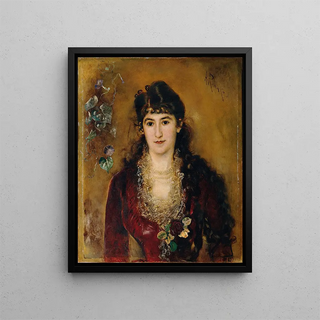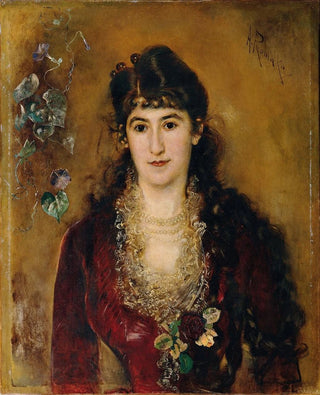Art print | Lady in Red Dress - Anton Romako


View from behind

Frame (optional)
Anton Romako's "Lady in a Red Dress" art print is much more than a simple painting; it is an invitation to immerse oneself in a world where beauty and elegance converge. This artwork, capturing the essence of a woman dressed in a striking gown, evokes deep emotions and an air of mystery. The vibrant color palette, combined with the artist's technical mastery, creates a composition that draws the eye and sparks the imagination. As you contemplate this piece, you are transported to a universe where every detail tells a story, where light dances on the fabric of the dress, and where the lady's face seems to whisper secrets of the past.
Style and uniqueness of the art print
Romako stands out with his distinctive style that blends realism and impressionism, creating an atmosphere that is both intimate and lively. In "Lady in a Red Dress," the texture of the gown is rendered with such precision that it almost feels tangible. The brushstrokes, both delicate and bold, reveal the artist's virtuosity while maintaining a certain fluidity. The lady's posture, both graceful and assertive, suggests a strong personality, while the blurred background enhances her presence, placing her at the center of attention. This art print perfectly illustrates Romako's ability to capture not only external appearance but also the very essence of his subjects, making each piece deeply personal and universal at the same time.
The artist and his influence
Anton Romako, born in 1848 in Austria, made his mark on his era with his innovative approach to painting. Influenced by the great masters of European art, he developed a style that is uniquely his own, integrating elements of tradition while embracing new ideas. His career, rich and varied, led him to explore various themes, but he always maintained a particular interest in female representation. The women he painted are not mere models; they are muses, symbols of passion and complexity. Romako thus contributed to redefining the female portrait in the 19th century, making his works

Matte finish

View from behind

Frame (optional)
Anton Romako's "Lady in a Red Dress" art print is much more than a simple painting; it is an invitation to immerse oneself in a world where beauty and elegance converge. This artwork, capturing the essence of a woman dressed in a striking gown, evokes deep emotions and an air of mystery. The vibrant color palette, combined with the artist's technical mastery, creates a composition that draws the eye and sparks the imagination. As you contemplate this piece, you are transported to a universe where every detail tells a story, where light dances on the fabric of the dress, and where the lady's face seems to whisper secrets of the past.
Style and uniqueness of the art print
Romako stands out with his distinctive style that blends realism and impressionism, creating an atmosphere that is both intimate and lively. In "Lady in a Red Dress," the texture of the gown is rendered with such precision that it almost feels tangible. The brushstrokes, both delicate and bold, reveal the artist's virtuosity while maintaining a certain fluidity. The lady's posture, both graceful and assertive, suggests a strong personality, while the blurred background enhances her presence, placing her at the center of attention. This art print perfectly illustrates Romako's ability to capture not only external appearance but also the very essence of his subjects, making each piece deeply personal and universal at the same time.
The artist and his influence
Anton Romako, born in 1848 in Austria, made his mark on his era with his innovative approach to painting. Influenced by the great masters of European art, he developed a style that is uniquely his own, integrating elements of tradition while embracing new ideas. His career, rich and varied, led him to explore various themes, but he always maintained a particular interest in female representation. The women he painted are not mere models; they are muses, symbols of passion and complexity. Romako thus contributed to redefining the female portrait in the 19th century, making his works






